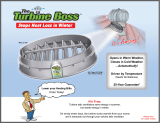Ingersoll-Rand TS999GZFA-L Installation And Maintenance Information
- Type
- Installation And Maintenance Information
This manual is also suitable for
The Ingersoll-Rand TS999GZFA-L Turbine-Powered Starter is designed for use in starting reciprocating internal combustion engines. It features air or gas operation and is suitable for off-highway, marine, and stationary applications. With a maximum air pressure of 90 psi (620 kPa), it delivers efficient starting power. The starter includes a 24-tooth pinion with a 1.2-inch pitch diameter and a 30:1 ratio. It is equipped with a dual-arc admission system that provides optimal air utilization and performance.
The Ingersoll-Rand TS999GZFA-L Turbine-Powered Starter is designed for use in starting reciprocating internal combustion engines. It features air or gas operation and is suitable for off-highway, marine, and stationary applications. With a maximum air pressure of 90 psi (620 kPa), it delivers efficient starting power. The starter includes a 24-tooth pinion with a 1.2-inch pitch diameter and a 30:1 ratio. It is equipped with a dual-arc admission system that provides optimal air utilization and performance.




















-
 1
1
-
 2
2
-
 3
3
-
 4
4
-
 5
5
-
 6
6
-
 7
7
-
 8
8
-
 9
9
-
 10
10
-
 11
11
-
 12
12
-
 13
13
-
 14
14
-
 15
15
-
 16
16
-
 17
17
-
 18
18
-
 19
19
-
 20
20
Ingersoll-Rand TS999GZFA-L Installation And Maintenance Information
- Type
- Installation And Maintenance Information
- This manual is also suitable for
The Ingersoll-Rand TS999GZFA-L Turbine-Powered Starter is designed for use in starting reciprocating internal combustion engines. It features air or gas operation and is suitable for off-highway, marine, and stationary applications. With a maximum air pressure of 90 psi (620 kPa), it delivers efficient starting power. The starter includes a 24-tooth pinion with a 1.2-inch pitch diameter and a 30:1 ratio. It is equipped with a dual-arc admission system that provides optimal air utilization and performance.
Ask a question and I''ll find the answer in the document
Finding information in a document is now easier with AI
Related papers
-
Ingersoll-Rand ST750GBDI03L32 Installation And Maintenance Information
-
Ingersoll-Rand ST999DP09L52 Installation And Maintenance Information
-
Ingersoll-Rand TS1499 Installation And Maintenance Information
-
Ingersoll-Rand QA1L High Torque Series Maintenance Information
-
Ingersoll-Rand QS1P Series Maintenance Manual
-
Ingersoll-Rand ST600 User manual
-
Ingersoll-Rand 44SMA Maintenance Information
-
Ingersoll-Rand SS825 Series Installation and Maintenance Manual
-
Ingersoll-Rand 150BMPC Series Installation And Maintenance Information
-
Ingersoll-Rand EMS-3100 Series User manual
Other documents
-
Amerimax Home Products 3012-12 Operating instructions
-
Apollo Conbraco 5900602 Installation guide
-
TOA MB-TS900 User manual
-
TRIANGLE TUBE Peerless Sealant Operating instructions
-
BENDIX PNU-192 User manual
-
ESAB FC-4 Potentiometer Assembly Installation guide
-
 Turbine Boss 100-A Installation guide
Turbine Boss 100-A Installation guide
-
TOA MB-TS900 Specification Data
-
Hubbell CHANCE PISA Locking Dog Assembly Operating instructions
-
Flowserve GTS Seal User Instructions




















